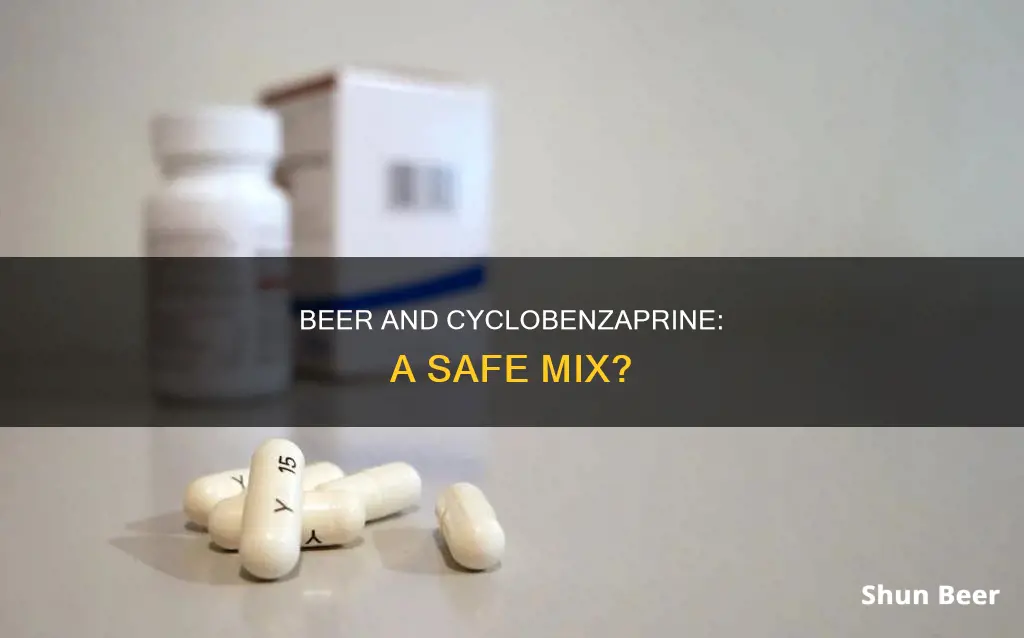
Mixing alcohol and prescription drugs can be dangerous, and this is no different when it comes to drinking beer and taking cyclobenzaprine. Both substances are central nervous system depressants, which means they slow down brain activity and functions such as breathing and heart rate, and can make you feel calm or sleepy. As such, drinking beer while taking cyclobenzaprine can compound its impact on your body and lead to intensified side effects, such as drowsiness, dizziness, reduced motor control, and impaired thinking and judgment.
| Characteristics | Values |
|---|---|
| Should you drink beer and take cyclobenzaprine? | No |
| What does cyclobenzaprine treat? | Muscle spasms, Musculoskeletal pain, Skeletal muscle conditions, strains, other muscle injuries, Back or neck pain |
| What are the side effects of cyclobenzaprine? | Blurred vision, Drowsiness, Dizziness, Headaches, Impairment in thinking and judgment |
| What happens when you mix cyclobenzaprine and alcohol? | Increased side effects such as slowed mental processing, decreased motor coordination, increased risk of abuse and psychological dependence, increased risk of seizures, increased risk of overdose, respiratory depression, slowed heart rate, impaired coordination, blackouts, difficulty breathing |
| What are the risks of mixing cyclobenzaprine and alcohol? | Addiction, physiological dependence, increased risk of accidents, liver damage, kidney damage, gastrointestinal problems, seizures, coma, death |
What You'll Learn

Increased risk of addiction
Mixing cyclobenzaprine and alcohol can increase the risk of addiction to both substances. Alcohol is the most widely abused substance in the United States, and its misuse is much more likely to cause physiological dependence than cyclobenzaprine. However, using the two together increases the likelihood of dependence.
Cyclobenzaprine is a muscle relaxant that works by blocking nerve impulses sent to the brain. It is typically prescribed to treat skeletal muscle conditions, strains, or other muscle injuries, as well as back or neck pain, usually for a short duration of two to three weeks. It is not a controlled substance, but it can only be obtained with a prescription and should be taken under medical supervision.
When taken as prescribed, cyclobenzaprine can provide pain relief, improve sleep, raise energy levels, and enhance motor functions. However, when misused or abused, especially in combination with alcohol, it can cause adverse effects such as slowed mental processing, decreased motor coordination, and impaired thinking and judgment. This combination can result in a sensation similar to opioids, greatly increasing the risk of accidents and injury.
The more these two substances are abused together, the higher the chances of developing an addiction. Addiction, or substance use disorder, is characterised by compulsive drug-seeking behaviour, cravings, and continued use despite negative consequences. Treatment for cyclobenzaprine and alcohol addiction typically begins with medical detox, followed by inpatient or outpatient treatment, including behavioural therapies and group therapy programs.
Beer and Gastric Patients: What's Safe to Drink?
You may want to see also

Heightened side effects
Mixing cyclobenzaprine and alcohol can lead to heightened nervous system side effects, such as dizziness, drowsiness, and impaired coordination. This combination can also lead to a reduction in mental alertness, with potential impacts on thinking and judgment. The mixture may also result in a sensation similar to opioids, increasing the risk of accidents.
As both substances are central nervous system depressants, they work to slow down brain activity, heart rate, and breathing rate. Together, they can cause a significant slowdown in mental processing and motor coordination. This can be extremely dangerous, especially for older individuals who are at an increased risk of falls and related injuries.
The combination of cyclobenzaprine and alcohol can also increase the risk of seizures, overdose, and respiratory depression. Respiratory depression is marked by an increased breathing rate, a bluish color around the mouth or fingernails, grunting during exhalation, flared nostrils, chest retractions, increased sweating, wheezing, and a forward-leaning body position while sitting. These signs indicate that the individual is struggling to breathe and may be on the verge of collapse.
It is strongly advised to avoid drinking alcohol while taking cyclobenzaprine. If you must consume alcohol, it is recommended to wait at least 24 hours after taking your last dose of cyclobenzaprine to avoid any harmful effects. However, due to the potential risks and side effects, it is generally best to refrain from mixing these substances.
Beer and Kidney Health: What's the Harm?
You may want to see also

Respiratory depression
The signs of respiratory depression include:
- An increase in the number of breaths per minute
- Bluish colouration around the mouth, inside the lips, or on the fingernails, indicating a lack of oxygen
- Grunting with each exhalation, as the body tries to keep air in the lungs
- Flared nostrils, signifying that the individual is working harder to breathe
- The chest appearing to sink in below the neck or breastbone, indicating a struggle to bring more air into the lungs
- Increased sweating and cool, clammy skin, which occurs when the breathing rate is rapid
- Wheezing, a whistling or rattling sound with each breath, indicating that the air passages might be smaller
- Leaning forward when sitting, which is usually a warning sign that the individual is about to collapse
If you or someone you know is experiencing these symptoms, seek immediate medical attention.
Thawing Frozen Beer: Is Drinking Safe?
You may want to see also

Overdose
Mixing cyclobenzaprine and alcohol is dangerous and should be avoided. Both substances are central nervous system depressants, and when combined, they can cause a range of adverse effects, including slowed mental processing, decreased motor coordination, and an increased risk of overdose.
While rare, a cyclobenzaprine overdose can be fatal, especially when the drug is abused in conjunction with other substances such as alcohol. In the event of an overdose, it is crucial to act quickly and seek immediate medical attention. Here are the steps to take if you suspect someone is overdosing:
- Look for signs of overdose, such as high blood pressure, irregular heart rate, and hypertension.
- Call emergency services right away and provide them with as much information as possible about the individual's condition and the substances they have taken.
- Place the person in the recovery position.
- If you are trained, perform CPR if the individual is not breathing and has no pulse.
- Stay with the person until emergency services arrive and continue to monitor their condition.
The signs and symptoms of a cyclobenzaprine overdose can develop rapidly and may lead to severe health consequences. It is important to be vigilant and seek help immediately if you suspect an overdose.
Beer and Inflammation: Is There a Link?
You may want to see also

Treatment for addiction
It is not recommended to consume alcohol while taking cyclobenzaprine, a muscle relaxant medication. Both alcohol and cyclobenzaprine are central nervous system depressants, which slow down brain activity, heart rate, and breathing, and can cause drowsiness and impaired judgment. Combining the two can lead to adverse side effects, including slowed mental processing, decreased motor coordination, seizures, overdose, and a sensation similar to opioid effects.
If you or someone you know is struggling with addiction to alcohol and/or cyclobenzaprine, it is important to seek professional help. Here is some information about treatment options for addiction:
Detox Treatment Facilities
Detox treatment centers provide support during the acute withdrawal phase, helping individuals manage the physical and psychological symptoms of withdrawal. This can include medication therapy, group therapy, individual therapy, and recreational therapy. It is crucial to be honest about your alcohol consumption when seeking treatment, as alcohol withdrawal can be severe and life-threatening.
Inpatient/Residential Rehab and Intensive Outpatient Programs
Inpatient rehab or intensive outpatient programs can provide ongoing support and help individuals navigate triggers and prevent relapse. These programs offer various therapies, such as group therapy, individual therapy, family therapy, nutrition counselling, exercise, and relaxation techniques. The length of stay in inpatient rehab can vary, with 28 days being the most common duration.
Partial Hospitalization Programs (PHP)
PHPs are non-residential programs that require individuals to attend therapy sessions for approximately four hours a day, five days a week. This option is suitable for those with underlying medical conditions who can live outside the treatment facility. PHPs provide diagnostic and addiction therapies to address both medical and psychological needs.
Intensive Outpatient Treatment (IOP)
IOPs involve attending intensive therapy sessions for three hours a day, five days a week, for a month or longer. This type of treatment is recommended for co-occurring disorders, such as depression, and includes behavioural therapies and group therapy sessions.
Outpatient Treatment (OP)
Outpatient treatment consists of therapy sessions that meet for six to nine hours per week, typically two to three times a week. This option requires individuals to take more responsibility for their recovery and is meant to address minor support needs.
Aftercare Programs
Aftercare programs provide ongoing support and assistance with housing, legal, and financial needs following the completion of substance use treatment. They offer a support network of individuals who understand the challenges of recovery and can help navigate any obstacles to sustained sobriety.
If you are concerned about your substance use or the substance use of a loved one, there are resources available to help. You can contact a treatment referral service, such as the SAMHSA National Helpline (1-800-662-HELP), to get connected to local treatment facilities, support groups, and community organizations.
Beer, Gout, and You: Stop Drinking, Start Healing
You may want to see also
Frequently asked questions
No. Beer and cyclobenzaprine are both central nervous system depressants, which means they slow down brain activity and can make you feel calm or sleepy. Combining the two can compound their impact on your body and lead to dangerous symptoms such as reduced motor control, risk of seizures, and risk of overdose.
The most common side effects of cyclobenzaprine include blurred vision, drowsiness, dizziness, and headaches.
Drinking beer while taking cyclobenzaprine can increase the nervous system side effects of the drug, such as dizziness, drowsiness, and difficulty concentrating. It can also impair your thinking and judgment and increase the risk of accidents.
Muscle relaxants like cyclobenzaprine usually last around four to six hours and have a half-life of eight to 37 hours in most adults. To avoid any harmful effects, it is recommended to wait at least 24 hours after taking your last dose of cyclobenzaprine before consuming alcohol.
If you have already mixed cyclobenzaprine and beer, stop drinking immediately and seek medical help as soon as possible, especially if you have had more than one drink or don't drink often. The combination can lead to an increased risk of overdose and other dangerous side effects.







